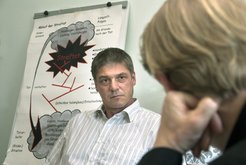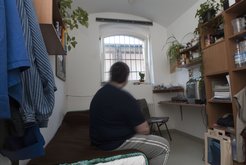Building blocks for a new life
Text: Klaus Wilhelm

Four carefully tended plants in very special planters – margarine tubs – are waging a lone campaign to counteract the monotony of the room. The room is small, not even 15 square meters. A chair, a bed, a small television set. The toilet is toward the front, near the door. Two shelves. Everything spick and span. There’s a feeling of order – two or three books, a couple of document folders. And an impressive model of the “Admiral Graf Spee,” a warship of the German Navy in the Second World War. “I enjoy making things with my hands,” says Frank S. Although 35 years old, you’d think from his appearance that he was 25. He sits upright on the chair and talks calmly.
Frank S. has abused children, mostly boys, sometimes girls. More than 100 times, for years. The room is a cell in the Waldheim correctional facility, just under an hour’s drive west of Dresden. As he talks, Frank S. appears relaxed, alert, at times somehow liberated. Just occasionally his eyes shift away and look troubled when he talks about the past. “The thing I thought about most was self-confidence,” he says. He didn’t have any. Almost every adult unknown to him was unapproachable. “How was I supposed to get to know a woman?” S. was shy and timid in a way that other people cannot even imagine.
“There is a big connection between that and what I did,” he says, “I longed for security and love.” The extremes of emotions were tearing him apart. All that remained were children, incomparably friendlier and more uncomplicated than any adult. And the loss of control. The complete lack of understanding that he was destroying the souls of his young victims. And what he was doing to parents and relatives.
Social therapy aims to promote resocialization
He uses psychological terminology, such as “cognitive distortion,” as naturally as other people mention “car” or “handbag.” Something he has learned to do during social therapy in the Waldheim facility – in other words, in treatment composed of a variety of therapeutic means and social aids designed to resocialize prisoners. The goal of the treatment is to show Frank S. how and why he came to do what he did, how he can change his behavior, how to establish himself once he’s been released, and how to work and function on the outside.

The treatment is made up of different strands – training in social skills needed for communal living, developing empathy and conflict management, acquiring self-confidence, working through disordered thought and interpretation patterns, and relapse prevention specifically for sex offenders. For a variety of reasons – political, emotional, populist – lawmakers decreed, with effect from January 1, 2003, that sex offenders sentenced to more than two years of imprisonment must be treated in an institution offering social therapy, provided such treatment is indicated. This proviso has created a certain amount of discretionary leeway for those responsible for implementing the law, namely the federal states and individual institutions.
The treatment would seem to be especially relevant for offenders with a significantly disordered personal and social development giving rise to the fear that they might commit dangerous criminal acts in the future. Treatment lasts for one and a half to three years, or up to four or five years in exceptional cases. “We start by taking everyone, at least for a three-month trial period,” says Michael Brinkmann, director of social therapy at Waldheim and deputy director of the correctional facility – even offenders who initially are not motivated at all. There is a good reason for this.
A preliminary assessment of the ongoing study being conducted in Waldheim by the Freiburg Max Planck Institute of Criminal Law in cooperation with the Saxon Ministry of Justice and the Institute for Criminology and Business Criminal Law at the University of Freiburg demonstrates the following: even prisoners who are totally unwilling at the outset may gain something from the treatment. Moreover, “Usually we would expect that the child abusers are the offenders who succeed because of their conforming social conduct. But these very rapists with antisocial tendencies, unwilling at the beginning of the social therapeutic intervention, drop out of the treatment far less than the former,” says project director Gunda Wößner.
As a psychologist in the department of criminology at the Freiburg-based Max Planck Institute, she knows how socially destructive child abuse and rape can be. “The topic keeps flaring up when people get together to talk in bars and also on TV talk shows,” she says. This is particularly true if an offender abuses or rapes again after release – and then all the more so if he has had social therapy while in prison.
The result is demands such as that recently made by the German FDP (Liberal Democratic Party) politician Christian Ahrendt, that “whenever an offender is convicted of a sex offense or of being in possession of child pornography,” he must be forced “to take sexual medical treatment.” In other words, treatment with medication that inhibits the sex drive. Alternatively, that all individuals with a single conviction should be “locked away” permanently, as former Chancellor Gerhard Schröder put it in 2001.
Personal interviews as the basis of the study
From the point of view of victims and their families, these demands are more than understandable because they are driven by pure fear and quite possibly also by the desire for retribution. “I don’t want anything to happen to my children, either,” says Gunda Wößner. Even so, for the researcher, such radical opinions smack of ignorance and a lack of detailed knowledge. On the one hand, “they contradict the tenets of a country founded on the rule of law and liberty,” whereas on the other, “reality is always more complex than any popular opinion.” Yes, a small number of sex offenders do benefit from medical treatment. Yes, social therapy can reduce the rate of offense-specific recidivism, depending on the study cited, by 12 to 20 percent.

But the questions currently being asked by researchers in criminology regarding social therapy go far beyond this. How successful is this treatment really? What exactly are the effective measures? Which types of offenders benefit from social therapy? And which don’t? What lies behind a relapse, and how can its likelihood be influenced? Can the rate of recidivism be further reduced by gearing the social therapy better and more specifically to the individual? Is the focus on sex offenders justified at all?
At present, the question of whether every sex offender should be required to undergo social therapy is still open, at least from the psychological point of view. “Treatment works somehow,” says Wößner, “but we have not determined precisely what works how and for whom.”
The purpose of the ambitious study – planned to last 15 years – of the Max Planck Institute in Freiburg and the social therapy departments of the Free State of Saxony is to provide new answers and to shed light on the confused mass of speculation. In this spirit, Gunda Wößner has been making regular trips from Freiburg to Saxony since 2006 in order to gather information, monitor the ongoing study and provide solutions for emerging issues. There she meets local colleagues, including Elke Wienhausen, who recruit prisoners receiving social therapy for the study and conduct interviews with the inmates. “They are usually friendly and glad that someone is listening to them,” says the sociologist, “no problems so far.”
The team working with Gunda Wößner has thus far conducted in-depth interviews with 106 sex offenders and 55 violent offenders before the start of their social therapy in the Waldheim correctional facility. The questions focus on all manner of personality, biographical, emotional and socio-economic issues. With standard psychological tests, but also with information gathering tools of their own design. Of the study participants, 69 have already been interviewed a second time – just before the end of treatment. In addition, another 150 prisoners who are serving their sentences in a regular correctional unit and are not undergoing social therapy have also been interviewed.
In the humane prison, a good social climate prevails
One year after their release, the subjects are interviewed a third time, if they are willing and can be traced. Additionally, the researchers evaluate their personal files and include the assessment of the therapists on each individual prisoner. Five years after release, the Freiburg-based researchers consult the data on the interviewees contained in the criminal records of the central federal register. Thus, the officially registered reoffenses can be traced.

Frank S. can only dream of release at the moment: his earliest release date for probation for good conduct is 2012. His cell is located in the renovated Building 1 in the correctional facility. When he peers through the bars, he sees a small town lying in a hollow surrounded by higher ground. On this summer’s day, the town magnificently confirms the publicity slogan “Pearl of the Zschopau Valley.”
The prison blends seamlessly into this image, almost as if the two had grown together. Were it not for the discreetly placed barbed wire coils on the white walls, it would scarcely be recognized at first for what it is. A lime tree and a church give the area the feel of a village green, and the simple strung-out buildings are more reminiscent of an old boarding school than a prison. Since its foundation nearly three centuries ago, the prison has been regarded as a model institution, as a contemporary of the time remarked back in 1791.
The interior of House 1 looks like a model, contemporary humane prison. “We no longer have gangways complete with railings outside the cells, as we did in the past, when the different stories were not separated by partition walls,” says security officer Steffen Rost, “you can hear the difference.” And it is true, it’s almost perfectly quiet – even at 5:00 p.m. when all the prisoners have returned to the wing. They gather together in light wells. They cook together. “They get along together without much trouble,” explains Rost. This is despite the fact that almost all of the approximately 300 prisoners are serving many years in custody owing to serious violent offenses or sex offenses.
Michael Brinkmann attributes this to the social therapy, among other things. “We see positive effects in the day-to-day life of the facility,” he says, “The social climate is improving appreciably.” He has been working with dangerous criminals in his capacity as a psychologist for 15 years “because I can really make things happen here,” he explains, “for people that really need it.” He is a committed champion of social therapy. “I believe in this concept,” he says with conviction, “doing nothing at all is not an alternative.”
The lowest of the low in the hierarchy
Frank S. was sentenced to a total of eight years of imprisonment and wanted to get out of regular imprisonment in Dresden “as soon as possible” and into social therapy at Waldheim – maybe because he saw it as a real opportunity to do something positive about his situation. Or perhaps because he hoped he would be released earlier. Perhaps because, as someone convicted of child abuse, he was the “lowest of the low” in the prison hierarchy and his life could be made a living hell. However, at first there was no room for him at Waldheim. The whole situation, the guilt feelings and black despair, culminated in 2007 in a suicide attempt. “They had to act quickly,” he says laconically. Early in 2008, he was transferred to Waldheim and started receiving social therapy.

Susann Gebhardt is a young social worker in the Waldheim social therapy team. She is small in stature and speaks with a decisive but empathetic tone. She needs both of these attributes when she works with a dozen prisoners, as she does now. Some seem extremely interested, whereas others seem nervous or stressed. Just like every week, today’s program includes training in social skills.
Gebhardt is standing in front of a board and is asking the group, “How can I be likable to people I don’t know? And speak to them?” She is asking for their thoughts that could get in the way of doing that. And also for feelings that give them a sense of confidence or uncertainty. Feelings! Some of them are confused and look away. This is a basic course dealing with the (most) elementary things that we normally learn as a child or a young adult. The fundamental principles of friendliness.
Sessions like this have been Frank S.’s first experience of hearing about his disordered relations with empathy, and of learning in role plays what empathy means. It is his first realization of how he came to commit his acts. For the very first time, he perceived the concept of cognitive distortion – the way he internally plays down and justifies his acts. “But the children were willing, I taught them something new.” Eliminating this sort of false reasoning from the ground up is one of the central themes of psychotherapy in social therapeutic treatment: blame should not be sought in others.
Together with the prisoner, the therapists develop an individual model of an offender’s delinquent behavior or disorder without dwelling too much on analysis. “It is important for them to understand the dynamics of their own actions,” says Max Planck Institute researcher Gunda Wößner, “but what the offenders need above all else are specific strategies related to their own situation for combating their disorders.” In the sense of cognitive behavioral therapy.
Practicing self-control, even in stressful situations. Accepting responsibility for their actions. A hard path that not all follow to the end. Some 10 to 15 percent withdraw from social therapy. There is something very odd going on here, in that dropouts, on average, become recidivists more frequently than offenders who do not even begin the treatment. “We don’t know why,” says Wößner, “and we want to get to the bottom of it.” Have the needs of this group not yet been addressed at all?
Frank S. wants to succeed. “My eyes have been opened,” he says. His upbringing was strict, and both his father and mother drank. He was teased at school for being overweight. As an adult, he lived with his mother for a long time. An extremely small circle of friends, not sexually active. The psychological report characterizes him as a well adapted, polite and helpful, aggression-inhibited young person – full of self-doubt and anxieties that drove him to commit “delinquent substitute behavior,” in the jargon of psychologists. Criminality is an extreme way of dealing with negative feelings. An extreme way that can be modified, if the circumstances are right.
Each offender Type needs custom-tailored treatment
Gunda Wößner sees S. as “an almost typical child abuser.” The typology of sex and violent offenders is one of her main scientific interests – from the therapeutic point of view. “Treating everyone with a ‘one method fits all’ approach is counterproductive,” says the psychologist. “Even in research, there is seldom any differentiation.” In her doctoral thesis, she identified various types of sex offenders – differences that might prove important for type-specific treatment:
- Over-conforming child abuse offenders like Frank S.
- Antisocial types who generally tend toward high criminality, violence, the infliction of physical injury, drug and alcohol abuse. As children they experienced acts of violence themselves and as adults consider themselves beyond all normal standards, according to the tenet: “The world is wicked, so I will take everything I want.”
- Morbid paraphiliacs – those with sexual perversions who stand out because of their highly abnormal conduct, culminating even in the murder of their victims.
- Low-ability offenders who, because of their lack of intelligence, do not know how to approach someone and how to experience intimacy.
- Offenders who at first glance do not stand out socially, but who tend to go to extremes in crisis situations: either incestuous acts with their own children (or children brought into the relationship by their partners) or rape of the (ex-)partner.

Initial evaluations confirm the typology, including those from the ongoing Waldheim study. An additional type is the offender, also antisocial, who commits his sex offenses almost exclusively in the family. “We are only now beginning to recognize this group properly because victims have recently become more confident about reporting the abuse,” emphasizes Gunda Wößner.
An important aspect of more individualized treatment in the sense of type-specific intervention are so-called “coping mechanisms,” – the inner resources that an individual develops to deal with negative feelings. “At this point, it is important to gear interventions to each offender type,” she says. The Waldheim study suggests that there are different types of violent offenders, “something that is often not brought out in the literature.” For example, there is the type who – at first glance – is quite normal, but in a crisis exhibits acts of severe violence and killing. Or a type of professional, highly antisocial offender who has specialized mainly in crimes involving robbery.
Ten euros per day
It is elementary especially for the aggressive, antisocial offender types to hold down a job in prison – this has much to do with the fact that these inmates are generally not used to full-time work. “They often do not know how to structure a day,” says Wößner. Work simplifies this enormously, and there is a large supply of work and production halls to do it in at Waldheim. Everywhere, men in blue trousers and striped shirts are busy working. Some seem to be rather reluctant, others seem to be concentrating. They are constructing lattices, binding books, making wood briquettes, drilling, sawing, operating lathes, milling. They make wiring looms for Mercedes for good money – about ten euros per day. Others are training to be welders, which will be a valuable qualification.

“If you make an effort,” says Steffen Rost, “you can really learn things here.” No less important – especially for the “antisocial types” – is the use of free time. For many of them, sports are their number one interest. Others paint, while some cook. “If they can’t learn how to use their free time sensibly, they are only a step away from dropping back into the criminal environment or their peer groups who hang around and become involved in shady activities,” says Rost. Reoffending is then more or less a certainty.
For Michael Brinkmann, “each percent” counts – that is, each percentage drop in the relapse rate attributable to social therapy. It is a matter of human suffering. A matter of the cost of enforcement. Yet, as Gunda Wößner emphasizes, it is not easy to say how often sex offenders without therapy relapse. Numerous figures are bandied about in the literature, depending on the particular design of the studies cited. Recidivism rates depend on the definition of successful treatment, on the length of time between treatment and the measurement of outcome, and on the offender types under investigation; therefore, results may diverge widely.
Recognizing the early indications leading to abuse
If only offense-specific relapses – meaning a repeat of the sexual delinquency – are considered, the rate is between 6 and 33 percent. However, for relapse in the sense of any other offense, the rates go up to as high as 70 percent. Jutta Elz of the Center for Criminology found that the frequency/recidivism rate for child sexual abuse is around 22 percent; for offenses with sexual violence, the rate is around 19 percent. The relapse rates established in various national and international studies are between 15 and 20 percent for rapists and between 6 and 24 percent for various forms of child sexual abuse.

The few studies conducted in German-speaking regions quote relapse rates of approximately 12 percent for serious child sexual abuse. According to studies so far conducted, offenders with a social therapeutic treatment are 8 to 20 percent less likely to reoffend with an offense-specific crime than offenders without such an intervention.
“Therapy achieves something,” stresses Wößner. However, preliminary results from the current study vary. According to some of the interviewees, they gained little or nothing from social therapy – whereas others say they benefited a great deal. As regards evaluation, the psychologist does not want to concentrate solely on the relapse rate. “Relapse is a very severe criterion, one that is not used in any other medical or psychological field – for example in treatment for depression – to determine whether or not treatment is meaningful.” What she also regards as important is whether a relapse is less serious than the original offense. Is there a very long delay before it occurs? Or can the former prisoner maintain a job?
The psychologist knows that it is very difficult to convey such views to the general public, and she says that “some are so much at risk of relapse that they can never be released.” But there will always be recidivists among the ones not obviously at risk of relapse. The only 100-percent-certain alternative is to keep every person ever convicted of a serious offense in preventive detention for the rest of his life. But: “Do we want to do this in a country based on the rule of law, such as ours?”
Frank S., a trained metal worker, has had further training in Waldheim as a machine cutter. And now he has started a course in technical drawing. He ought to be able to make a go of working again. But that is not necessarily the problem for him. He hopes that the therapy will help him overcome his disorder. The fact that he can engage in conversion with “a complete stranger, a journalist” is confirmation for him of his newly acquired confidence. “That would have been impossible before the therapy.”
Therefore, S. hopes that the prevention strategies he has learned will work. And that he will always remain aware of “how it used to be.” That he will recognize the thoughts and warning signs that lead to abuse. That he will then be able to use the resources that give him self-control. And that he will find friends to help him “lead a new life.”
GLOSSARY
Cognitive behavioral therapy
A form of psychotherapy that aims to modify dysfunctional cognitions – one’s attitudes, thoughts, evaluations and beliefs – through special therapeutic techniques. The underlying premise is that a particular manner of thinking determines how we feel and behave and how we react physically.
Preventive detention
A measure involving deprivation of liberty intended to protect the general public from dangerous offenders after they have served their normal custodial sentence. The degree of danger must be established in an expert opinion report. Preventive detention is still carried out in correctional facilities, although detainees are granted more privileges than are regular prison inmates. The German federal government intends to pass a new law on preventive detention.



















